Very Pretty Lace Scarf In Coorie
Lace may conjure delicate gowns or teatime tablecloths, but what about when you knit lace in 100% super kid mohair? Well, then it’s delicate and beautiful, but also soft and cozy!
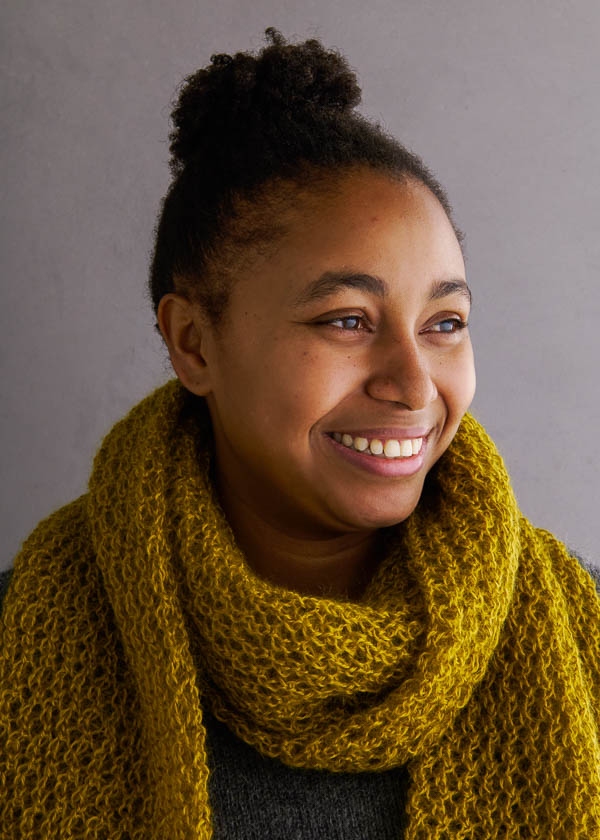
Our new Coorie brings a lush beauty to our Very Pretty Lace Scarf. Its subtle glisten and slightly fluffy halo ensure that it is very pretty, indeed!
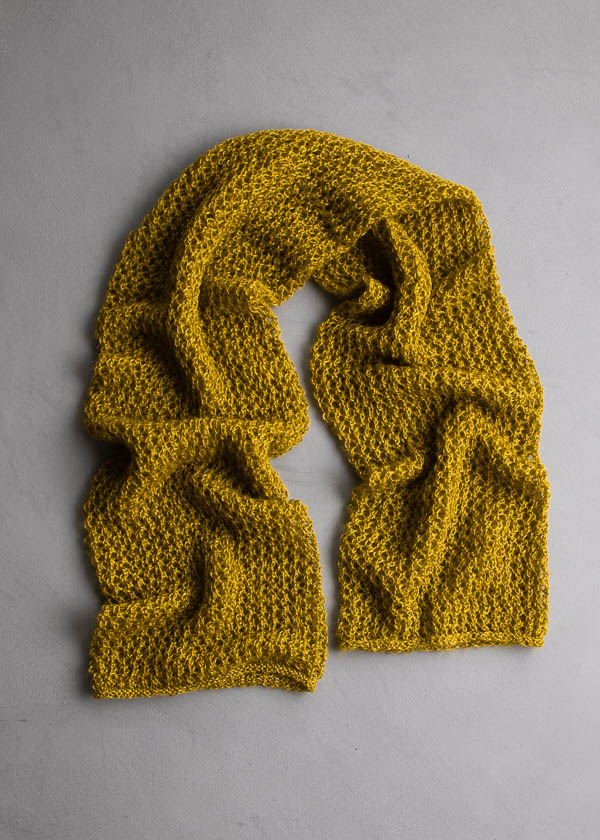
Originally published in Purl Soho co-owner Joelle Hoverson’s More Last Minute Knitted Gifts (now out of print), this simple pattern is still a total keeper! Knit in the round, it is a wonderfully voluminous tube with no wrong side and the oomph to wrap buoyantly around your neck.
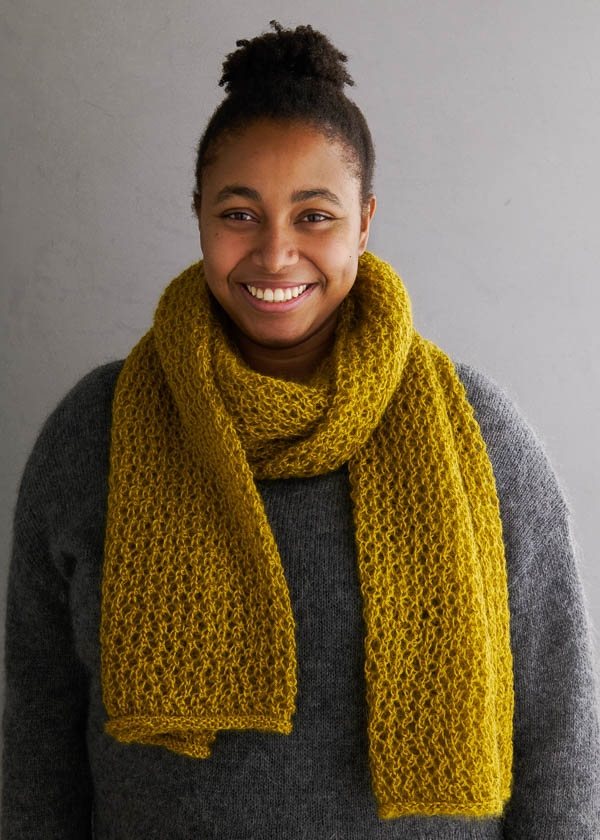
A no-sweat four-row repeat, the only stitches you’ll need beyond knits and purls are knit 2 together’s, slip slip knits, and yarn overs. So straightforward, you can use all that extra brain space to think about the beauty your own two hands are creating!
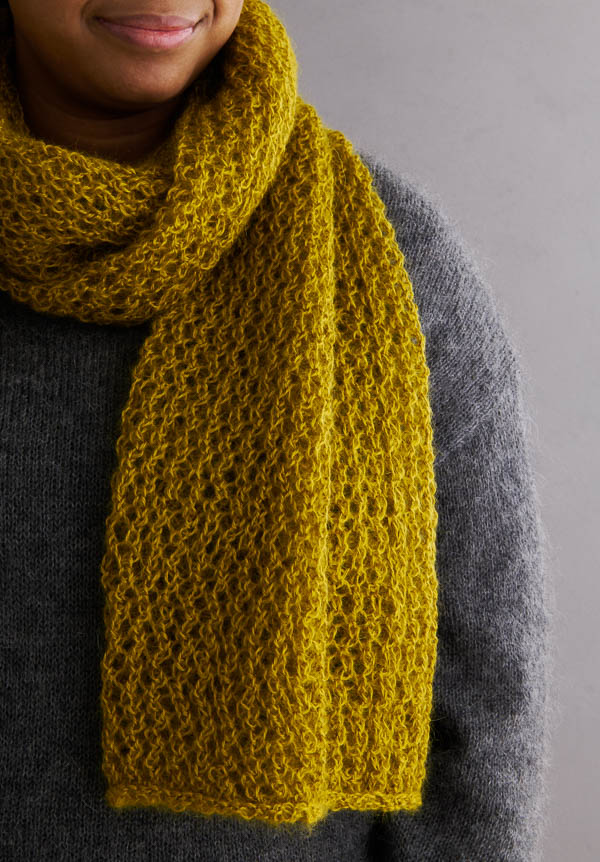
To get started, pick up six skeins of Coorie… Maybe in this magnificent Wild Mustard color, or in whatever very pretty color you choose for your Very Pretty Scarf!
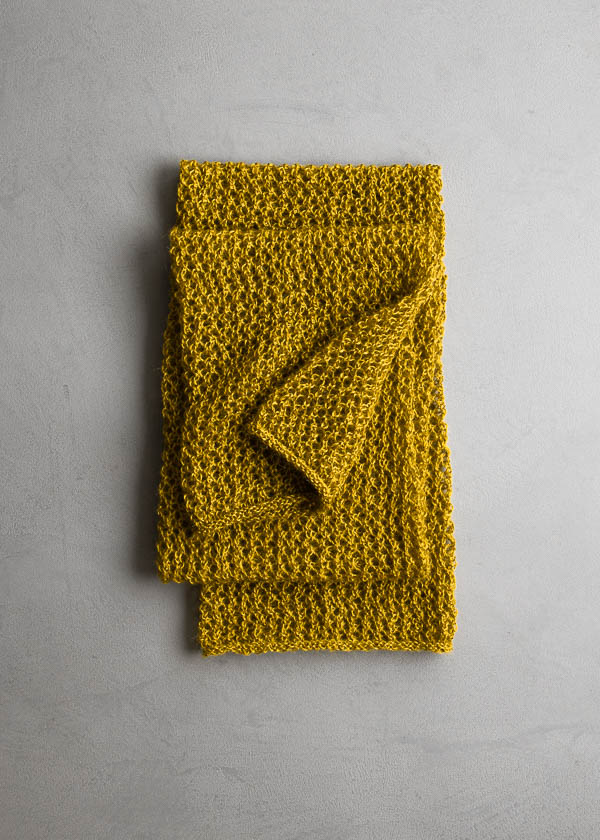
UPDATE: NOW IN QUARTZ
SEPTEMBER 2022
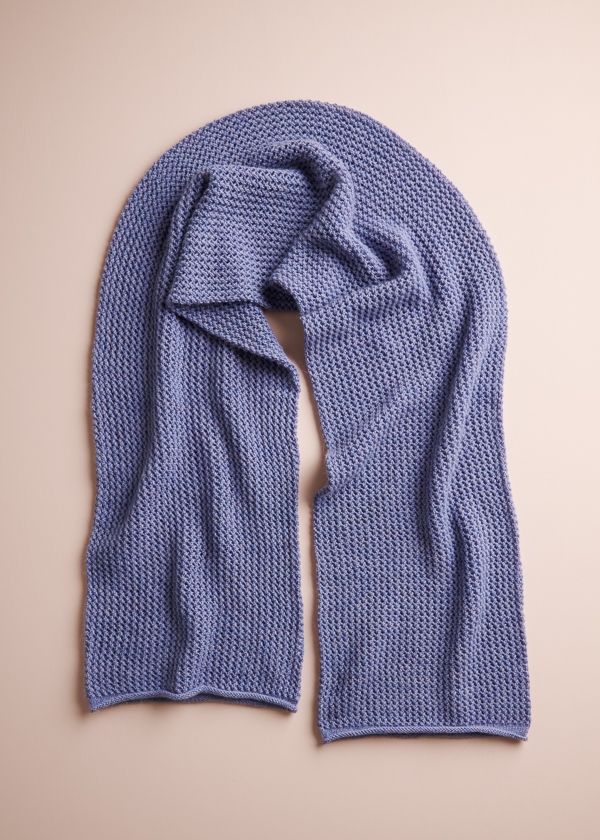
Knit in our merino-suri Quartz, our Very Pretty Lace Scarf is warm, soft, and has a delicate halo. Quartz takes dye beautifully, seeming to glow like its namesake, and a gently heathered mélange of color adds even more depth and interest to this scarf. We used lovely Hydrangea Blossom, anticipating a need for a mid-winter pick-me-up, but take a look and pick the color that lifts your spirit… Very pretty, indeed!
Designed by Purl Soho founder and co-owner, Joelle Hoverson.
Share your progress + connect with the community by tagging your pics with #PurlSoho, #PurlSohoBusyHands, #PurlSohoVeryPrettyLaceScarf, and #PurlSohoCoorie. We can’t wait to see what you make!
Materials
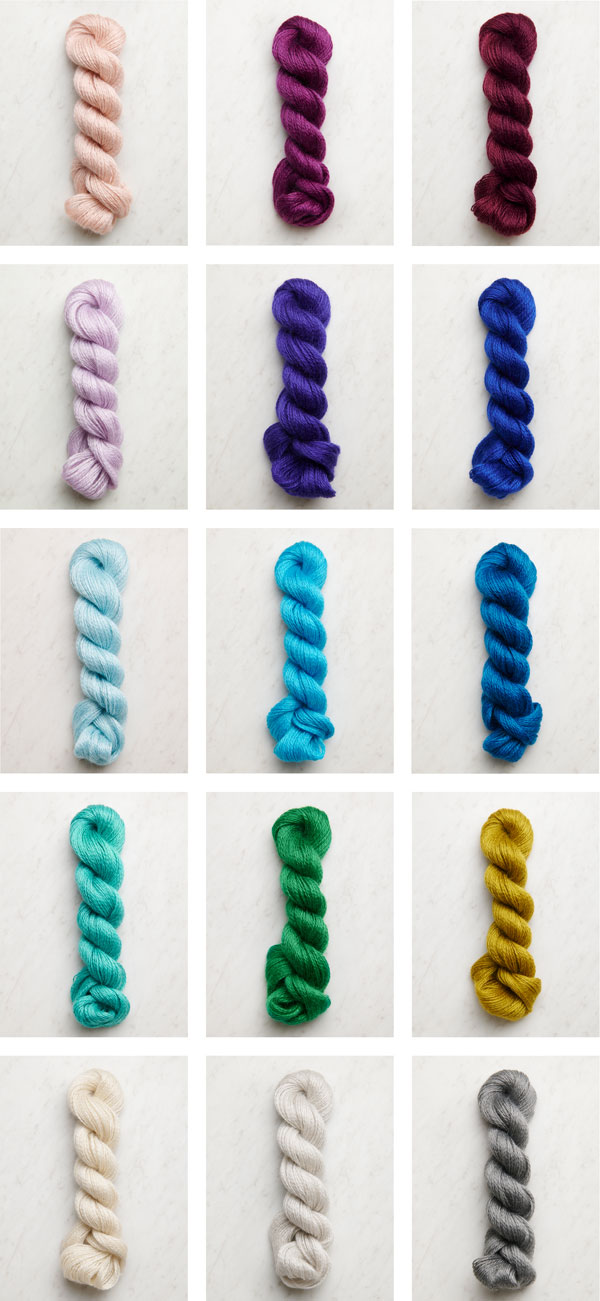
- 6 skeins of Purl Soho’s Coorie, 100% super kid mohair. Each skein is 137 yards/ 50 grams; approximately 783 yards required. We used the color Wild Mustard. (NOTE: We no longer offer Coorie, but choose from one of our other sport weight yarns.)
- US 7 (4.5 mm), 16-inch circular needles
- A stitch marker
Gauge
15 stitches and 32 rounds = 4 inches in stitch pattern
19 stitches and 24 rounds = 4 inches in stockinette stitch
Size
Finished Dimensions: 10½ inches wide (21 inches in circumference) x 70 inches long
Note
To change the finished circumference, cast on any odd number of stitches.
Pattern
Use a basic Long Tail Cast On to cast on 79 stitches.
Place marker and join for working in the round, being careful not to twist the stitches.
Bottom Edge
Knit each round until piece measures 1 inch from cast-on edge (unrolled).
Body
Round 1: Knit to end of round.
Round 2: K1, *yarn over (yo), knit 2 together, repeat from * to end of round.
Round 3: Knit to end of round.
Round 4: *Slip slip knit, yo, repeat from * to last stitch, k1.
Repeat Rounds 1-4 until piece measures approximately 69 inches from cast-on edge (unrolled).
Top Edge
Knit each round for 1 inch.
Bind off loosely knitwise.
Weave in ends and block as desired.
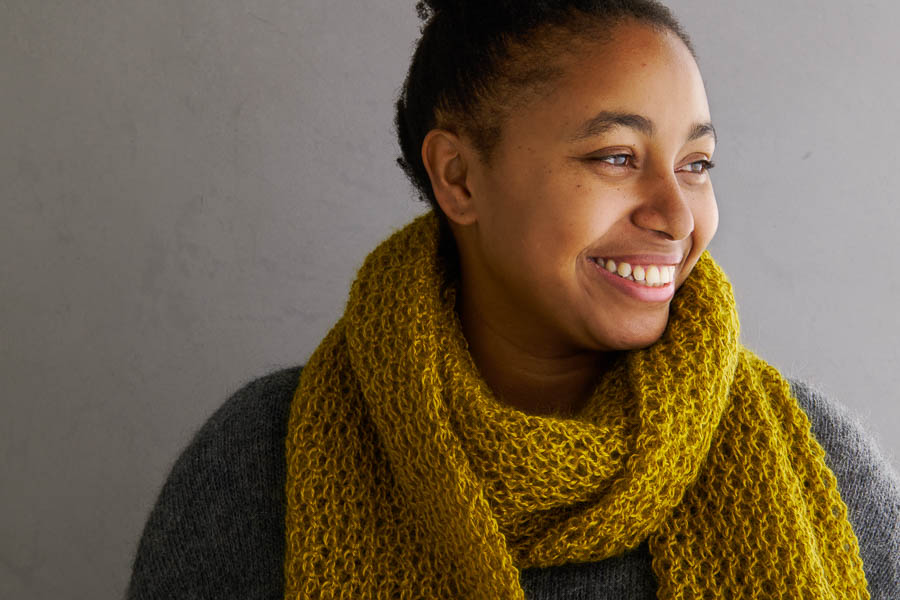
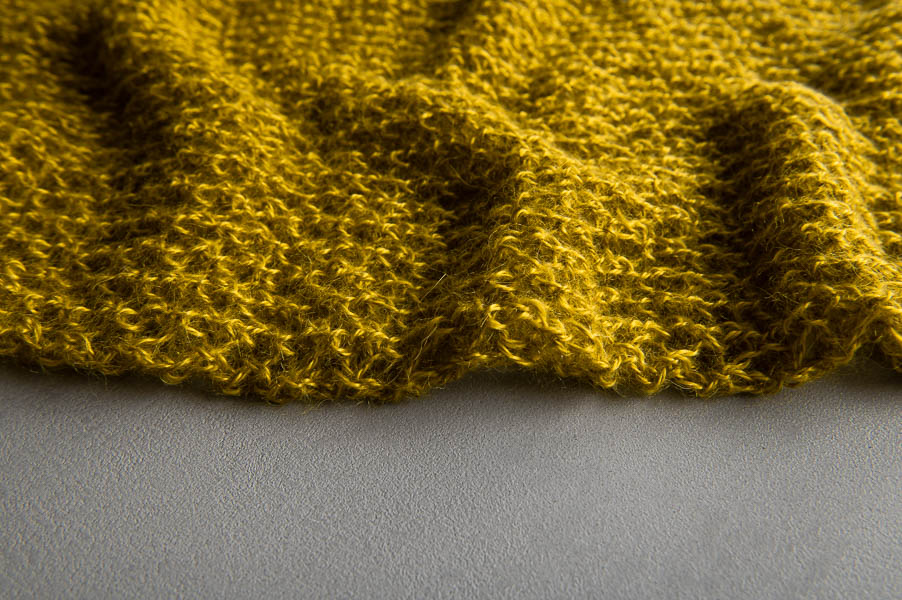
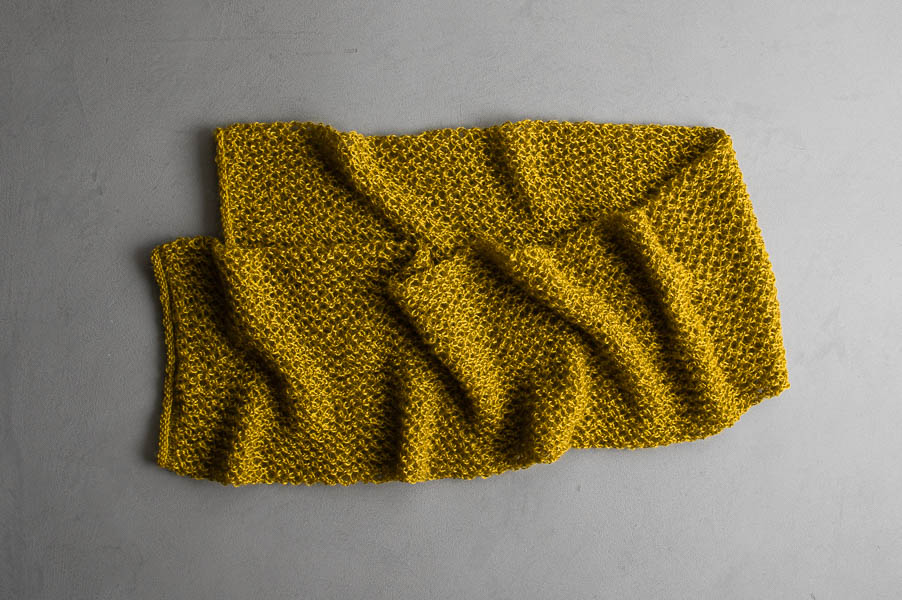


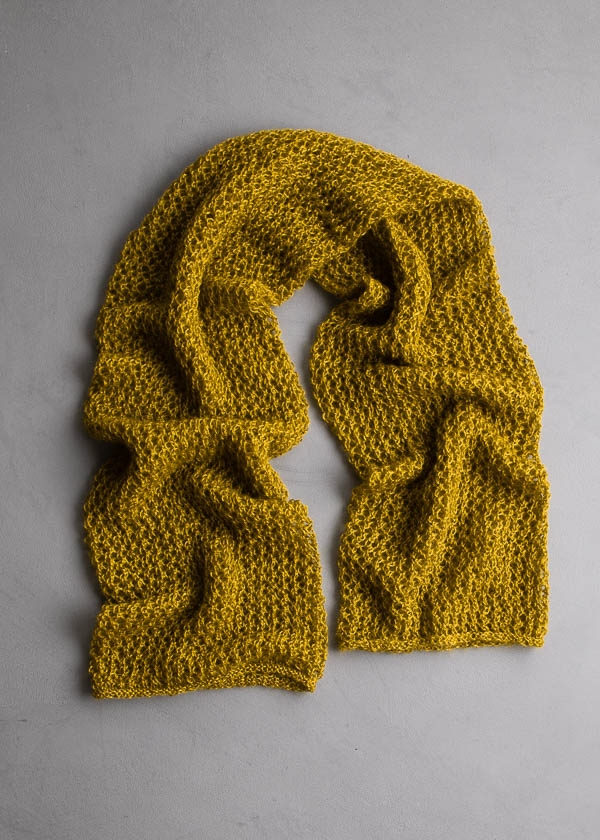
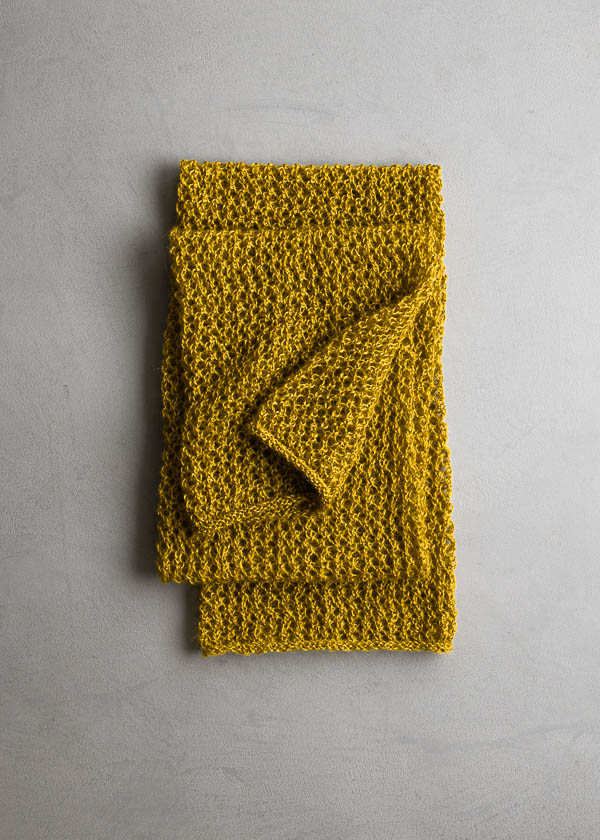

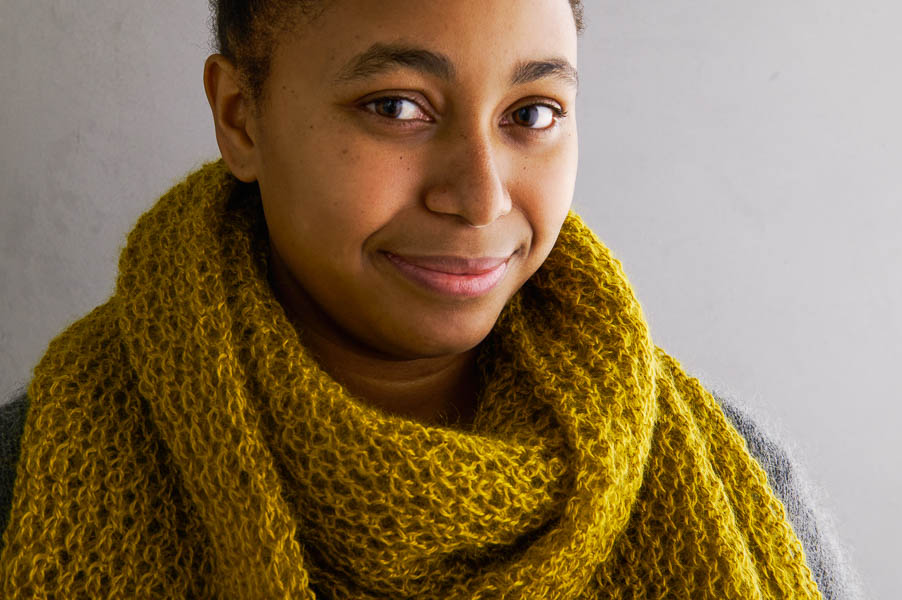
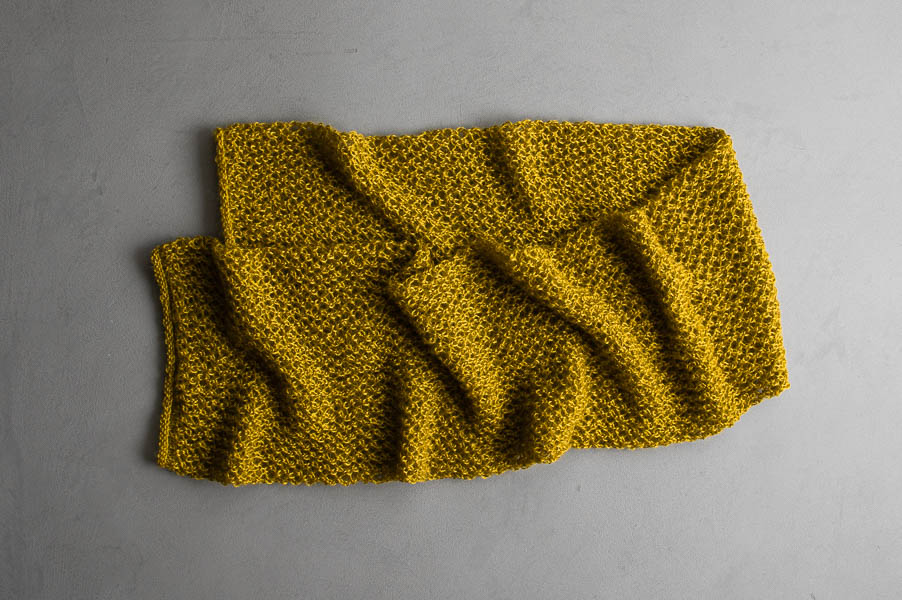
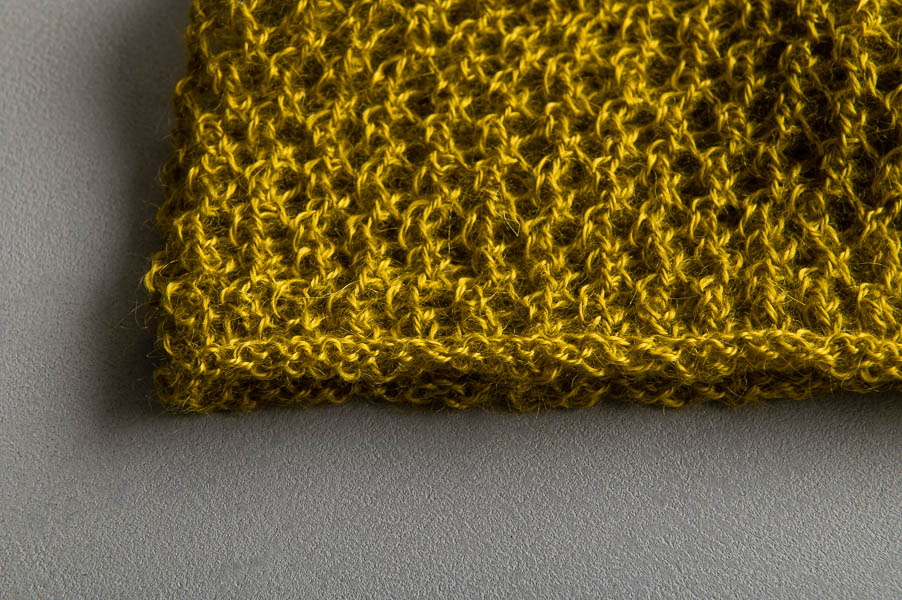
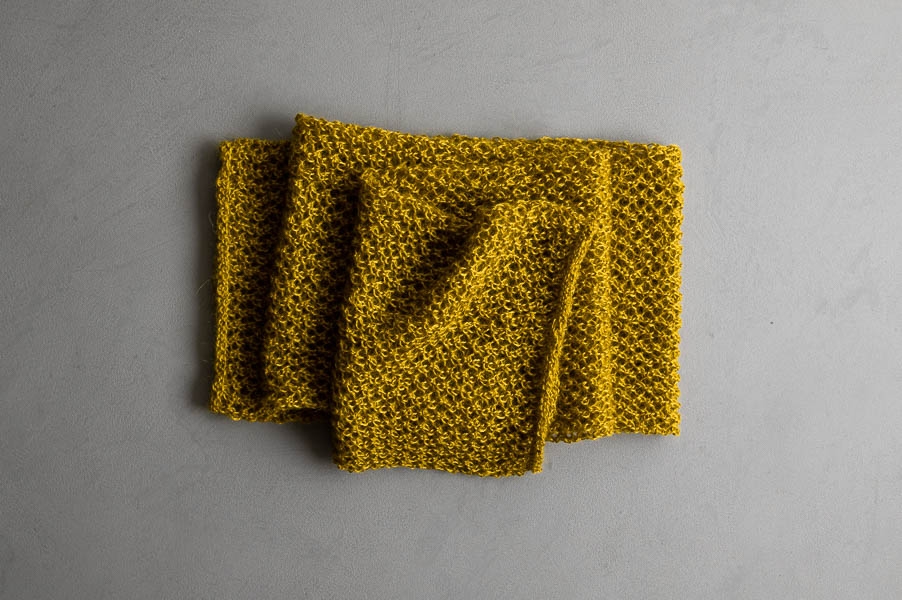


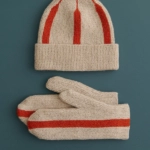
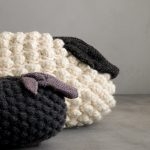
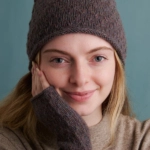
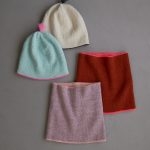

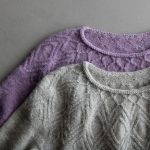
How long would it take to knit for a new knitter with the required stitches and skills?
Hi Edith,
Thanks for reaching out! Although I don’t have an exact estimate of how long this project will take you, since it totally depends on the skill level/style of knitting and of course the amount of time you have available to spend on it, I can say that this is a bit of a time consuming project! Since it is lace and requires a bit more technique it will take a bit more time to make!
I hope this helps, happy knitting!
Gianna
Yes, the scarf is beautiful and looks simple to make. However (hum), the 4th round is not clear at all; *slip slip knit, yo* to last st, k 1, end of round. Is that pattern with 3 sts or 4 sts??? What is the yo and what does the yo go over? How many sts involved in that? I hope my question is clear.
Thanks
Ruth
Hi Ruth,
Thanks for reaching out! Since this is a lace pattern, this is how you will be creating that effect! For round 4 you are working a Slip Slip Knit (knitting 2 stitches together, decreasing by 1 stitch) and then working a Yarn Over (wrapping the way around your needle, which essentially makes a stitch.) You will repeat the ssk decrease and yo increase until you reach the final stitch, knitting it. You will be working over 79 stitches through out the scarf!
I hope this clears things up for you!
Warmly,
Gianna
Hi I ended up adjusting this to knit this straight with other thicker yarn (and didn’t want to do it in the round as the result would not be as fluffy) so just replaced the knit rows with purl rows to get the same effect and it works. Hope this helps.
Hi Lula,
Thanks for writing in! I am so glad to hear this turned out well, and I am sure this will be very helpful for other knitters!
All the best,
Gianna
Lovely pattern. I’d like to knit up a shawl. Can you send me mods to make this pattern. Also would like to knit a cowl, hat (bonnet) and mittens.
Thks
Cheryl
PS I finally received gentle giant yarn and knitted the cowl. Just beautiful. A 1-2 hr project max. Easy and lovely.
Hi Cheryl,
Thanks for reaching out! We currently only offer written instructions for this pattern as a scarf (knit in the round!) However, since it is worked in the round as a tube, you could easily adjust the cast on (casting on any odd number of stitches) to create a cowl! Thank you for expressing your interest in a hat, shawl and mittens with this stitch pattern, I will be sure to pass this along to the design team!
Warmly,
Gianna
Dear Purl Soho,
For those of us who enjoy knitting in the round….and prefer long cowls to scarves….
You have so many lovely patterns for scarves and wraps that would make beautiful cowls. Could you please design some long cowls, just as lovely, in the round to be knit on circular needles and that do not have to be joined?
Please consider and thank you for the inspirations and tutorials!
R
Hi Risa,
Thanks for reaching out and sharing your opinion with us! This scarf is actually knit in the round as a “tube” so you could easily adjust the cast on to make this pattern into a cowl! For our full selections of cowl patters you can click here! Thank you for expressing your interest in more cowls, I will be sure to pass this along to the rest of the team.
Warmly,
Gianna
Can this scarf knit on straight needles?
Hi Soni,
Thanks for reaching out! Straight needles would not work for the pattern as written since this pattern in worked as a “tube” in the round. And at this time we only offer written instructions for working this stitch in the round, but if you are up for a bit of a challenge you could adjust this pattern to be worked flat! Just be sure to keep in mind that the pattern only offers instructions for the right side rounds, not wrong side rounds!
I hope this helps and please let me know if you have any more questions!
Warmly,
Gianna
Other than the lace scarf pattern are there any other scarf patterns that would work well with the coorie yarn? I have 5 skeins on hand but do need a pattern that is feminine looking but works up quicker.
Hi Barbara!
Thank you for your question! Some other lace scarf patterns that we have that might work for Coorie are the Open Air Wrap, the Lace Columns Wrap, and the Aperture Wrap. You can also browse our entire collection of scarf patterns here! Any of these would be a great choice for Coorie, however your gauge will change across these different patterns since you will be using a different weight of yarn, so that is something to keep in mind!
I hope this helps, but please let us know if you have any other questions!
All the best,
Margaret
What is “slip slip knit” in above pattern?
Thank you.
Hi Linda,
Thanks for reaching out! Slip slip knit is a decrease, similar to a k2tog decrease! You can find our lovely tutorial for this decrease here!
I hope this helps and please let me know if you have any more questions!
Warmly,
Gianna
I’ve tried this pattern and it’s not working out the same as the picture. Is there a video of this? Thank you.
Hi Irene,
Thanks for reaching out! We don’t have a tutorial for this particular pattern, but we do offer excellent tutorials for the techniques used: Knit Two Together (k2tog), Slip Slip Knit (ssk) and Yarn Over (yo)!
I hope this helps and please feel free to reach out with any more questions!
Warmly,
Gianna
I also cannot make this work and I’m a decades-long knitter. I’ve tried 3 times and re-checked the instructions each time. The problem seems to be in the 4th row where I’m losing a stitch, all the while following exact instructions. Any help available?
Hi Francesca,
Thanks for reaching out! I am sorry to her that you are having problems with this! I actually knit this sample (shown in the photos) so I know this pattern is correct as written. Row 4 works over the exact same amount of stitches as row 2, you are working the same amount of yo and ssk as you do with the yo and k2tog, so there should virtually be no difference between the two rows except that one starts with a K1 while the other ends with a K1! My best guess is that you are either missing a yo or working an extra ssk causing you to come up short on that row.
I hope this helps and please let me know if you have any other questions!
Warmly,
Gianna
I believe if you want to knit a flat piece on straight needles, you would change the knit row to a purl row, because you would be looking at the back of the work. I have a question about the SSK directions. Why do you slip the second stitch purlwise instead of knitwise?
Thanks for the beautiful patterns, so generous!
Hi Sue,
Thanks for reaching out and for your kind words! Yes that is correct, to knit this pattern flat you would work rows 2 and 4 on the right side and rows 1 and 3 on the wrong side!
For the ssk you slip the 2nd stitch purlwise so that the first leg of the stitch is facing forward, and so when you slip the 1st stitch knitwise the 2nd leg of the stitch is also facing forward. In other words the 2nd leg of the 1st stitch and the 1st leg of the 2nd stitch should both be oriented forward. This gives the decrease its left slant! You can see exactly how to work this decrease in you Slip Slip Knit (ssk) tutorial!
I hope this helps and please let me know if you have any more questions!
Warmly,
Gianna
Hi,
I can’t do mohair. Do you recommend a sport yarn with good halo, or a DK?
Hi Megan,
Thanks for reaching out! I would recommend checking out our sport weight Mulberry Merino or our dk/light worsted weight Cashmere Merino Bloom! both of these yarns over time will give off a nice halo effect! I recommend double checking your gauge with either one of these before beginning the pattern!
I hope this helps and please let me know if you have any more questions!
Warmly,
Gianna
I seem to be coming up short on my stitch count after Row 4. Do I need to do a YO before I begin SSK?
Thank you
Harry
Hi Harry,
Thanks for reaching out! My best guess is that you may be missing a YO somewhere in the row, but you do not start the row off with a YO. It should be *Slip slip knit, yo, repeat from * to last stitch, k1.
I hope this helps and please let me know if you are still coming up short!
Warmly,
Gianna
The yarn over tutorial explains how to move to yarn to front or back depending on whether following with a knit or purl stitch in order to create a new stitch. Will the YO after a SSK be the same as a YO between two knit stitches? The yarn is always in the back on a SSK, so seems the YO would be created by moving the yarn to the front and then around to the back for the next SSK. Thank you.
Hi Kathy,
Thanks for reaching out! Yes that is correct, after working a ssk you will bring the yarn to the front and then wrap it around the needle to the back!
Warmly,
Gianna
I’m getting close to my first join. What join would you recommend for this pattern and yarn?
Thank you!
Hi Kathy,
Thanks for reaching out! For this scarf we used the basic method Adding a Ball of Yarn! I recommend joining in when you are on one of the knit rounds to avoid any complications with the yo or ssk/k2tog!
Happy knitting!
Gianna
I would like to make this scarf narrower by 35-38% . How many stitches should I cast on an how many skeins to buy?
Hi Nirelle,
Thanks for reaching out! 30% less than 10.5 inches wide would be about 7″ wide, so I would suggest casting on 67 stitches and I would recommend 5 skeins to be safe!
Warmly,
Gianna
I also am having a problem with the 4th row of the lacy scarf do you slip 1, slip the 2nd stitch then knit one and pass the knitted stitch over the 2nd slipped stitch?
Hi Mary,
Thanks for reaching out! For row 4 you are not actually slipping stitches or passing stitches over, you are working a slip slip knit decrease, also known as ssk. This is a very common decrease that is also comparable to a k2tog except that it is left leaning rather than right leaning!
So essentially row 4 is very similar as row 2 just with a different decrease. You will be ssk, yo and repeating that to the last stitch, then k1.
To see how to work a ssk please view our Slip Slip Knit (ssk) tutorial (this tutorial is also linked in the pattern in the highlighted pink text!)
I hope this clarifies things!
Gianna
I am a long time knitter but casting 79 stitches on a size 7 16” needle with cookie yarn is impossible to join. What on earth am I doing wrong?
Hi Kathryn,
Thanks for reaching out! Can you tell me a little more about what part of the joining you’re having trouble with? Are you finding that you need a shorter cord length? Or that your stitches are twisting when you try to join in the round? I know that Coorie is a slick yarn, so it might also be helpful to try working with wooden needles rather than metal needles to give the yarn a little more resistance and help prevent stitches from falling off accidentally!
All the best,
Kelsey
I am using a wooden needle. The problem is that the yarn doesn’t stretch enough to join. I am supposed to be using a 16” (size 7) needle correct? I have co 79 stitches but joining in the round is impossible. I love the Coorie yarn but co 79 stitches on a 7 needle (16” in length) isn’t working. I know the yarns band says suggested size is 3-4 so I thought I might have misread the directions. I have made many items in the round. Could you please help me? Thank you.
Hi Kathryn,
Thanks for reaching out! Yes, the pattern is correct, we used a US 7 16″ circular needle for this project and cast on 79 stitches! You won’t want to go down in needle size because that would affect the overall density of the fabric and change the lace pattern. I actually knit this sample and experienced a bit of tightness when first joining the work in the round, however, it is completely possible! You will just need to coax the stitches around the needles a bit for the first row but once you join and work a few more rows it won’t be tight at all and you will be able to comfortably knit in the round!
I hope this clears things up, happy knitting!
Gianna
Hello,
I’d like to make this but longer and narrower. What would the cast on be to narrow it to say, 7-8 inches instead of 10.5?
Thank you!
Jessica
Hi Jessica,
Thanks for reaching out! Luckily this pattern is very easy to adjust! If your gauge is consistent with the pattern, I would suggest for 7 inches to cast on 53 stitches and for 8 inches to cast on 61 stitches! Just be sure to cast on an odd number of stitches for the pattern to work accurately.
I hope this helps and please let me know if you have any more questions!
Gianna
I love this pattern and just bought the yarn . After reading all the comments I’m afraid that as a intermediate knitter it will be too hard. Any pointers to avoid problems?
Love your patterns and your yarns.
Terri
Hi Terri,
I think this would be the perfect project for an intermediate knitter! I would suggest, however, if you’re unfamiliar with any of the techniques, to get a sense for them before you begin. Fortunately, we offer some wonderful tutorials on all these techniques, and I’ll link to them directly, here: Yarn Over (yo), Knit Two Together (k2tog), Slip Slip Knit (ssk). I have so much confidence that you’ll be able to make this scarf!
All the best,
Lili
Hi there,
I am making this pretty scarf after a long time away from knitting, and I love the yarn. My test square came out at the right gauge, but I’m finding some of the stitches a little tight to work, and my neck is getting sore. At about halfway through my first skein, I’m only at 4 inches. 6 skeins x 8″ would just be 48 inches; does this mean I’m knitting too tight and should size up my needles and start over? Thanks for your help!
Hi Ariel,
Thanks for reaching out! This scarf can be a bit deceiving while knitting, it will scrunch up quite a bit but once you block the finished scarf it will come out much longer! To get an accurate measurement I would suggest gently pulling on the scarf!
I hope this helps, happy knitting!
Gianna
I have always done ssk by slipping the 2 stitches separately both slipped knitwise and then knitted together knitwise. Your ssk youtube shows slipping the first stitch knitwise, the 2nd purlwise and then knitting together purl wise. Why? Is this usual? Is this done in this pattern for decorative purposes? What would happen if I knitted ssk as I usually do? Have to admit that most of my ssk’s are either on socks or raglan sleeves.
Hi Amy,
Thanks for reaching out, and that’s a great question! Like many techniques in knitting, there are multiple ways to work an ssk. It took some testing to land on working our ssk’s that way, with one slipped one way and one slipped the other. We found this way to best manage tension the best and also mirror k2tog (for all those patterns with mirrored shaping). But it’s totally up to you which method you choose for this project!
All the best,
Lili
Why do you cast on an odd not even number of stitches? Is it so round 2 and round 4 will not line up but will rather alternate? I typically put markers every 10th stitch to make counting easier. In order for the holes (decreases) in the pattern to alternate, should I have 9 stitches at the beginning of my counting or at the end? Does it make any difference? Would it be easier if I didn’t mark out every 10 stitches but rather put in 1 marker at the beginning of the round and just knitted 79 stitches? Not sure I’ve made this clear.
Hi Amy!
Thank you for your questions! This pattern is worked over an odd number of stitches so that the lace design will turn out as an interwoven checkerboard instead of striped yarn-overs. The Knit 1 at the beginning of row 1 does offset the design so that you have “X” shaped lattice of stitches instead of stripes of lace.
Because these rows rely an on odd number of offset stitches, I would suggest counting your stitches at the end of each row, instead of using markers, to that you do not have to worry about whether a marker is before or after a yarn over, for example. However, if you wanted to include a removable stitch marker on the right side of your fabric, that might help you keep track of right side and wrong side rows!
I hope this helps clarify the odd stitch count!
All the best,
Margaret
I am working in the round so there shouldn’t be a right or wrong side. I had figured that the odd number would keep the pattern from being striped yarn overs. I have removed the markers except for one which delineates the beginning and end of the round ie separates stitch 1 from stitch 79. Knitting in the round, I would guess that the first and last stitches (1 and 79) would move 1 stitch to the left because of the odd number? That assumes that round 2, k2tog would end with 1 stitch at the end and one at the beginning being knit together. Not sure whether round 4 would always end with k1 as stitch 1 (the beginning) or stitch 79 (the last stitch). Thanks for your help.
Hi Amy,
It sounds like Margaret’s advice has been helpful so far! To clarify your question about Round 4, this round will indeed always end with a k1 (as stitch 79), and it will always begin with an ssk (as stitch 1).
All the best,
Lili
Margaret,
I finally figured out my mistake and problem. The pattern stitch actually repeats every 3 not 4 stitches with the one extra stitch (the 79th) a knit at the beginning of round 2 and at the end of round 4. I had been knitting a 4 stitch repeat including a knit stitch as the 4th. Don’t know whether that makes any sense to you but I am ready to start all over again. BTW the 1 inch of st st is very hard to rip out because of the mohair though the couple of rows of pattern came out quite easily.
Thanks for your help and glad that your support helped me to hang in until I had figured out what was going on.